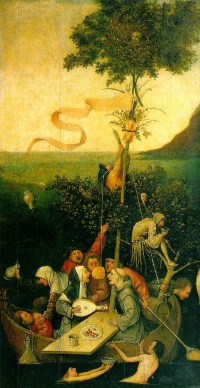Ship
From The Art and Popular Culture Encyclopedia
(Difference between revisions)
| Revision as of 22:18, 9 September 2010 Jahsonic (Talk | contribs) ← Previous diff |
Revision as of 15:07, 25 August 2017 Jahsonic (Talk | contribs) Next diff → |
||
| Line 1: | Line 1: | ||
| + | [[Image:Ship of Fools by Jheronimus Bosch.jpg|thumb|right|200px|''[[Ship of Fools (painting)|Ship of Fools]]'' by [[Hieronymus Bosch]]]] | ||
| {{Template}} | {{Template}} | ||
| - | :On the raft, the situation deteriorated rapidly. Men began to throw wine and flour out of spite and fight among themselves. On the first night 20 men – whites and [[Africa]]ns, soldiers and officers – were killed or committed suicide. Rations dwindled ever more rapidly and on the fourth day some on the raft resorted to [[cannibalism]]. On the eighth day, the [[fittest]] began throwing the weak and wounded overboard. By that time only fifteen men remained, all of whom survived until their rescue a week later. | ||
| - | The '''''Raft of the Medusa''''' (Le Radeau de la Méduse) is a painting by the French painter [[Théodore Géricault]], and one of the icons of [[French Romanticism]]. An extremely large painting (491 × 717 cm), it was highly [[controversial]] at its first appearance in the [[Salon (Paris)|Salon]] of [[1819]], attracting passionate [[critical acclaim]] and [[condemnation]]. The painting depicts the desperate survivors of the [[France|French]] [[ship]] ''[[Medusa (ship)|Medusa]],'' which gained notoriety when it struck the coast of [[Senegal]] in [[1816]], and their first moment of apparent rescue. Much of the controverse was sparkled because of the survivors of the sinking of ship had resorted to [[cannibalism]] after four days adrift on a raft. | + | In modern parlance a '''ship''' has been any large [[Buoyancy|buoyant]] [[watercraft]]. Ships are generally distinguished from [[boat]]s based on size, shape and [[cargo]] or passenger capacity. Ships are used on [[lake]]s, [[sea]]s, and [[river]]s for a variety of activities, such as the [[ferry|transport of people]] or [[cargo ship|goods]], [[fishing]], [[cruise ship|entertainment]], [[Coast guard|public safety]], and [[warship|warfare]]. Historically, a "ship" was a [[sailing vessel]] with at least three [[square rig|square-rigged]] masts and a full [[bowsprit]]. |
| - | + | ==See also== | |
| - | The painting was a political statement – the incompetent captain was an inexperienced but politically sound anti-Bonapartist – and an artistic achievement that galvanized romantic painting and led to a break from the [[neoclassical style]]. The work was realized on the epic scale of a [[history painting]], yet was based on a current news story. The unblemished musculature of the central figure, waving to the supposed rescue ship, is reminiscent of the neoclassical, but the painting is broadly romantic. The naturalism of light and shadow, authenticity of the haggard bodies, and emotional character of the composition, differentiate it from neoclassical austerity. The ''Raft of the Medusa'' was a further departure from earlier works because it depicted contemporary events with ordinary and unheroic figures, rather than religious or classical themes. However the ragged state of the figures' clothes means that the "unromantic" nature of modern dress was an issue that could be largely bypassed. | + | *[[Ship of fools]] |
| - | + | *[[Ship of Theseus]] | |
| - | Impressed by accounts of the shipwreck, which had received huge publicity, the 25-year-old artist Théodore Géricault decided to make a painting based on the incident and contacted the authors of published accounts in 1818. In order to make his ''Raft of the Medusa'' as realistic as possible, Géricault made sketches of bodies in the morgue of the [[Hospital Beaujon]]. The painting depicts a moment recounted by one of the survivors: prior to their rescue, the passengers saw a ship on the horizon, which they tried to signal (it can be seen in the upper right of the painting). It disappeared, and in the words of one of the surviving crew members, "From the delirium of joy, we fell into profound dispondency [sic] and grief". The ship, the ''Argus,'' reappeared two hours later and rescued those who remained. | + | |
| - | + | ||
| - | After by the hostile reception of his ''Medusa'' in France, Géricault went to London in [[1820]], after having his picture shipped to England, where a traveling showman exhibited it in several towns. | + | |
| - | + | ||
| - | Géricault used friends as models, notably the painter [[Eugène Delacroix]] as the figure in the foreground with his face turned downward and arms outstretched. | + | |
| - | + | ||
| - | A bronze bas-relief of the painting adorns Géricault's grave in [[Père Lachaise Cemetery]] in [[Paris]]. The painting was bought by the [[Louvre]] from his heirs after the artist's death in 1824. | + | |
| {{GFDL}} | {{GFDL}} | ||
Revision as of 15:07, 25 August 2017
|
Related e |
|
Featured: |
In modern parlance a ship has been any large buoyant watercraft. Ships are generally distinguished from boats based on size, shape and cargo or passenger capacity. Ships are used on lakes, seas, and rivers for a variety of activities, such as the transport of people or goods, fishing, entertainment, public safety, and warfare. Historically, a "ship" was a sailing vessel with at least three square-rigged masts and a full bowsprit.
See also
Unless indicated otherwise, the text in this article is either based on Wikipedia article "Ship" or another language Wikipedia page thereof used under the terms of the GNU Free Documentation License; or on research by Jahsonic and friends. See Art and Popular Culture's copyright notice.


